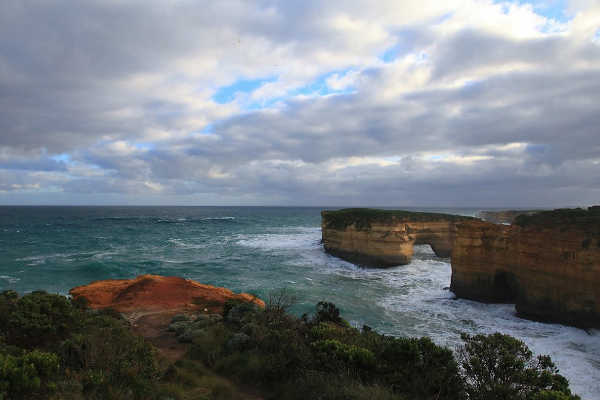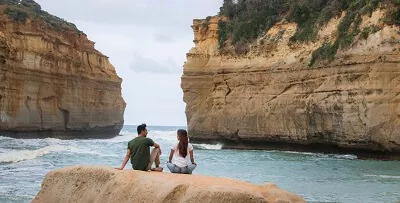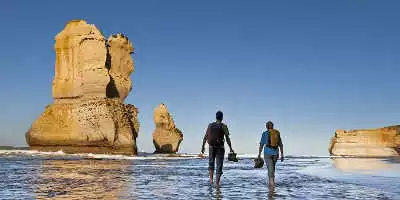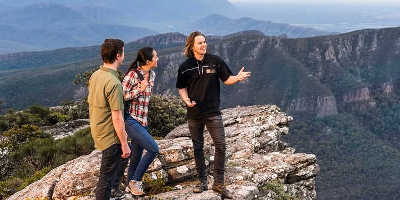
Shipwreck Coast, Great Ocean Road
Port Campbell, Victoria 3269
Australia’s Shipwreck Coast forms part of the Great Ocean Road, spanning from Moonlight Head to the small fishing village of Port Fairy.
Along the way, there are plenty of sights and attractions to take in, including Princetown, the famous Twelve Apostles, Port Campbell, Peterborough, and Warrnambool.
The stretch of coast is thought to have around 700 shipwrecked vessels submerged in its waters, and it is the history that makes it such a fascinating place. Despite the number of shipwrecks in this stretch of water, it is estimated that only around 240 have been discovered. Some divers opt to explore Shipwreck Coast by getting up close and personal with some of the wrecks that are a glance into the pages of history. It’s popularity as a diving spot has increased immensely over the years, though divers do need to pay attention to the water conditions as some sites require perfect weather and water conditions to explore some wreckages safely.
Matthew Flinders notably said he had never seen a “more fearful section of coastline” – no surprise, considering the Shipwreck Trail along the coast acts as a graveyard for ships that have been brought down either by the dangerous weather, human error, or foul play.
The Most Famous Shipwreck
Perhaps the most famous shipwreck story is that of the Loch Ard, which disappeared on its way to Melbourne from England. Caught up in fogs along the coast, the captain thought he was miles away from the cliffs of the Australian mainland, but in fact, he was fatally close.
The huge ship hit Mutton Bird Island on the 1st June 1878, killing 52 of the 54 people on board. The only survivors were Eva Carmichael and cabin boy Tom Pearce, who managed to spend the night in a cave before climbing the cliffs and finding help once the bad weather had cleared.
Wreck Beach Walk
A secluded spot nestled between dramatic cliff faces will lead you to Wreck Beach. Though the journey there may be a little tough (it’s around an hour and a half to get here on a 2-kilometre trail), the end result is surely worth it. Here you’ll discover the anchors of two ships that ran aground- Fiji and the Marie Gabrielle.
What Ships Were Wrecked Along The Coast?
-
Marie Gabrielle
This French barque ran aground in the middle of the night in 1869. Much to the surprise and alarm of the lighthouse keeper’s children, the crew of this ship had stumbled upon the lighthouse after 3 days without food and water. As there was a language barrier between the groups, the lighthouse keeper was called and housed these crew members for over a month until the boat came that could transport them to Melbourne.
-
Newfield
In 1892, the Newfield ran aground on route to Brisbane. The captain of the barque mistakenly believed the ship was in the direction of Cape Wickham when he was actually on course to Cape Otway. The ship collided with the coast and huge swells caused it to wreck. Out of the 29 lives on board, 9 were lost that fateful day.
Why is Shipwreck Coast so dangerous?
A fierce wind that blows in from the Antarctic which causes huge swellings in the waves that crash against the shore. The jagged coastline and dense fog that covers the area is a Ship Master’s worst nightmare when combined with the unbeatable wind. Many wrecks occurred as a result of bad navigation by confused captains who believed they were further away from shore than they were. For some ships, the wreckages happened quickly, often taking passengers with it down to its murky ocean floor. However, for those who had realised the mistake earlier on, passengers and/or crew quickly abandoned ship. Often was the case that the ship could not be salvaged as it was a dangerous and costly endeavour.
Things to Do Along Shipwreck Coast
- Make your way down the Gibson Steps, a staircase etched into the cliffs. From the bottom you can catch a glimpse of the Twelve Apostles from sea level, taking in their sheer, impressive beauty.
- Take a quick detour to Timboon, where you can try the Schulz family’s organic cheeses. Their farm is famous in the area for producing local, creamy wheels. With four generations of cheese making in the Schulz family tree, you can enjoy a country-style lunch amidst a beautiful natural landscape, tasting cheese and wine as you go.
- Play golf with a view at Peterborough, which boasts a course on top of a cliff. Here, you can marvel at the stunning coastal scenery while you take your swings.
- If you want to experience what port life might have been like back in the 19th century, head to the Flagstaff Hill Maritime Village in Warrnambool, where there is an interactive historic display with tonnes of information, documents, and images to soak up.
- Take a leisurely stroll around the state game reserve at Tower Hill and breathe in the fresh sea air. The reserve has been restored to its former glory with the help of a von Guerard painting.
- If you’re up for the challenge, why not try the Great Ocean Road Walk? There are over 104 kilometres of walking tracks to explore, stretching from Apollo Bay to the 12 Apostles. Here’s your chance to see the surf, sand and nature all in one.
- Visit the Cape Otway Lighthouse, the oldest surviving lighthouse on the Australian mainland. It was affectionally referred to as the ‘Beacon of Hope’. It was given this nickname after it was constructed because it was pivotal in assisting ships on their course to land along the treacherous Shipwreck Coast.











